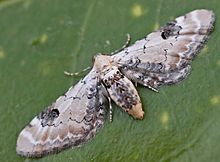Lime-speck pug
| Lime-speck pug | |
|---|---|
 | |
Scientific classification | |
| Kingdom: | Animalia |
Clade: | Euarthropoda |
| Class: | Insecta |
| Order: | Lepidoptera |
| Family: | Geometridae |
| Genus: | Eupithecia |
| Species: | E. centaureata |
Binomial name | |
Eupithecia centaureata (Denis & Schiffermüller, 1775)[1] | |
Synonyms | |
| |
The lime-speck pug (Eupithecia centaureata) is a moth of the family Geometridae. It is a common species throughout the Palearctic region (where it is found in Europe, Central Asia, Mongolia, southern Siberia, eastern China (Guangdong) and Taiwan[2]), the Near East and North Africa.
Contents
1 Description
1.1 Larval food plants
2 References
3 External links
Description
This is a distinctive species, all the wings being largely white except for a black blotch on the costa of the forewing. The wingspan is 20–24 mm. Often two broods are produced each year and the adults can be seen at any time during the summer and autumn. The moths fly at night and are attracted to light and nectar-rich flowers.
The larva is rather variable but is usually green or yellow, often with red markings. It feeds on the flowers of a variety of plants (see list below). The species overwinters as a pupa.

Larva
Larval food plants
Achillea – yarrow- Angelica
Arctium – burdock- Artemisia
Calluna – heather- Campanula
- Centaurea
Cirsium – thistle- Crambe
Filipendula – meadowsweet
Galium – bedstraw
Hieracium – hawkweed
Lotus – bird's-foot trefoil
Lysimachia – yellow loosestrife
Matricaria – mayweed
Medicago – alfalfa
Pimpinella – burnet saxifrage
Rumex – sorrel
Selinum – milk-parsley
Silene – bladder campion
Solidago – goldenrod
Tanacetum – tansy
Trifolium – red clover
Vicia – tufted vetch
References
^ Taxapad
^ Mironov, V.G. & A.C. Galsworthy, 2007: The genus Eupithecia (Lepidoptera: Geometridae) in Taiwan: an updated survey. Trans. lepid. Soc. Japan. 58 (3): 341–363.
- Chinery, Michael. Collins Guide to the Insects of Britain and Western Europe (1986, reprinted 1991)
- Skinner, Bernard. Colour Identification Guide to Moths of the British Isles (1984)
External links
 Media related to Eupithecia centaureata at Wikimedia Commons
Media related to Eupithecia centaureata at Wikimedia Commons Data related to Eupithecia centaureata at Wikispecies
Data related to Eupithecia centaureata at Wikispecies- Lepiforum.de
This Eupithecia moth related article is a stub. You can help Wikipedia by expanding it. |

 Clash Royale CLAN TAG#URR8PPP
Clash Royale CLAN TAG#URR8PPP